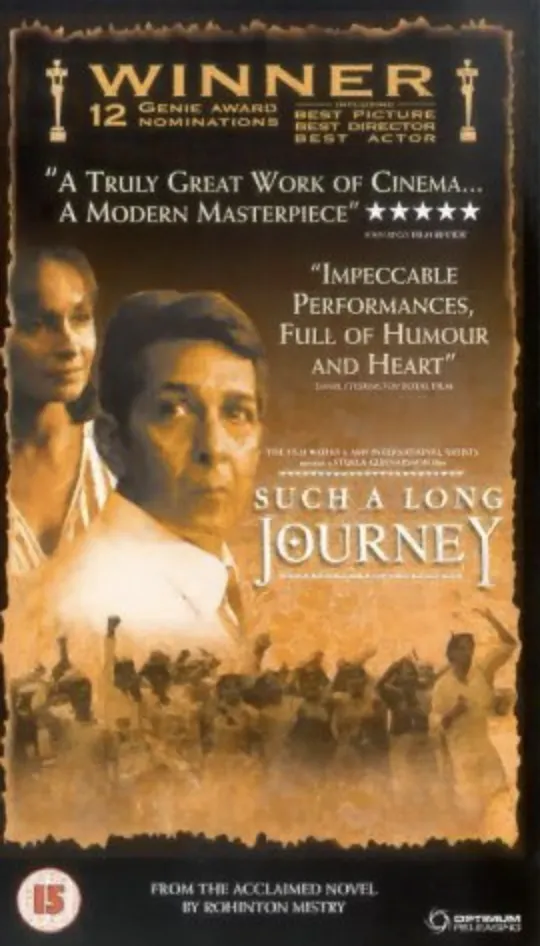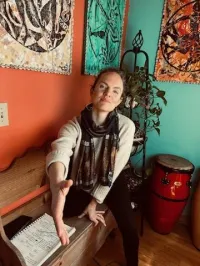BLOG
Soul Work Report

Such a Long Journey
I remembered a film I saw many years ago that eloquently spoke of grief and transformation, and I sought it out.
I was able to figure out the title by searching on https://movieuncover.com and watch it on Tubi: "Such a Long Journey." I invite you to watch as well. The main character, Gustad, a father, starts the film by tearing away the dark paper from the windows- put up to keep their lights hidden from bombers during the night- to let the morning light in. He reminisces on his childhood of comfort and luxury in Bombay before India's independence from Britain- in sepia tones. We get to know his family: wife, son just leaving high school, younger son, and 5-ish-year-old daughter. We get to know his neighbors and co-workers at the bank. He wants to live a virtuous life. His son does not wish to follow his father's path and go to college. In his righteousness, the father disowns his son and throws him out. Out of love for his longtime friend Jimmy, who left to aid the Bangladeshi Resistance, he begins depositing stolen government money into the Resistance's bank account. Loss after loss starts to come his way. His gregarious and inappropriate friend at the bank, who was collaborating to deposit the money, slowly declines and dies under the pressure of having to remain silent. His friend Jimmy is killed by those opposing Bangladeshi freedom. Finally, his neighbor with a disability is killed when protesters in front of their compound are throwing bricks, and he walks out into the situation, unaware. Gustad carries his body into the house and holds his bloody head while he thanks Gustad and dies. His son Saurab comes home, and they embrace, Gustad covered in blood.
The film ends with Gustad tearing away the paper from the windows to let in the morning light- in sepia tones. The same moment that was in the full color of the present at the beginning of the film.
I found this film device incredibly powerful. It's used in other films as well. Sepia tones signal memories and nostalgia. Yes, time passes, and things that happened previously become the past. But beyond that fundamental movement, life moves in cycles. Cycles where we repeat our current life indefinitely until a change occurs- either forced upon us by events that affect us or from within. We ultimately cannot control events that happen around us. We can affect things to a certain extent. Gustad was able to get people to stop urinating on the compound wall by asking an artist to paint a mural of gods and goddesses on the wall. When the artist made the wall sacred, they no longer had to tell people to stop urinating there. They transformed the space, and people adjusted their behavior accordingly. People brought flowers and candles of devotion and money for the artist. Even so, the wall was later destroyed, as ordered by the city. Yet, I wonder where else we can apply this insight. When else can we solve our problems by making the problem sacred? When else can we find a way forward by accessing the artist within us?
My question is- how do we level up? How did Gustad move away from the lingering grief and nostalgia of losing class status compared to his luxurious childhood? Nostalgia wasn't working. He disowned his son when he was trying to demand that his son follow the path that worked in the past- his & his parents' path to success. He moved past this inflexibility that caused him to lose his son only when he became involved in helping the Resistance and became fully engaged in trying to reduce the suffering of those closest to him. His daughter caught malaria and literally became the thermometer that measured his attention to his center, his family. Only when he brought his attention to her did her fever subside. There is no one way to level up and enter a new realm of possibilities. May our transformations come without crises. And when crises come, may we see them as the initiations that they are.
We can look for models of these transformations around us. We can listen to our heart as it speaks in our relationships. We can look at our feelings with a steady gaze and recognize them for what they are. We can release the emotions we carry from past relationships into present ones. And start again. It is such a long journey- the journey within ourselves to expand our circle of concern, aligned in integrity and love.

FREE DOWNLOAD
Headline that hooks people in and makes them want to sign up.
Add a subline here lorem ipsum dolor sit amet, consectetur adipiscing elit praesent ut neque ipsum mauris sit amet urna consectetur
© Copyright 2023 Business Name - Privacy Policy - Terms & Conditions
